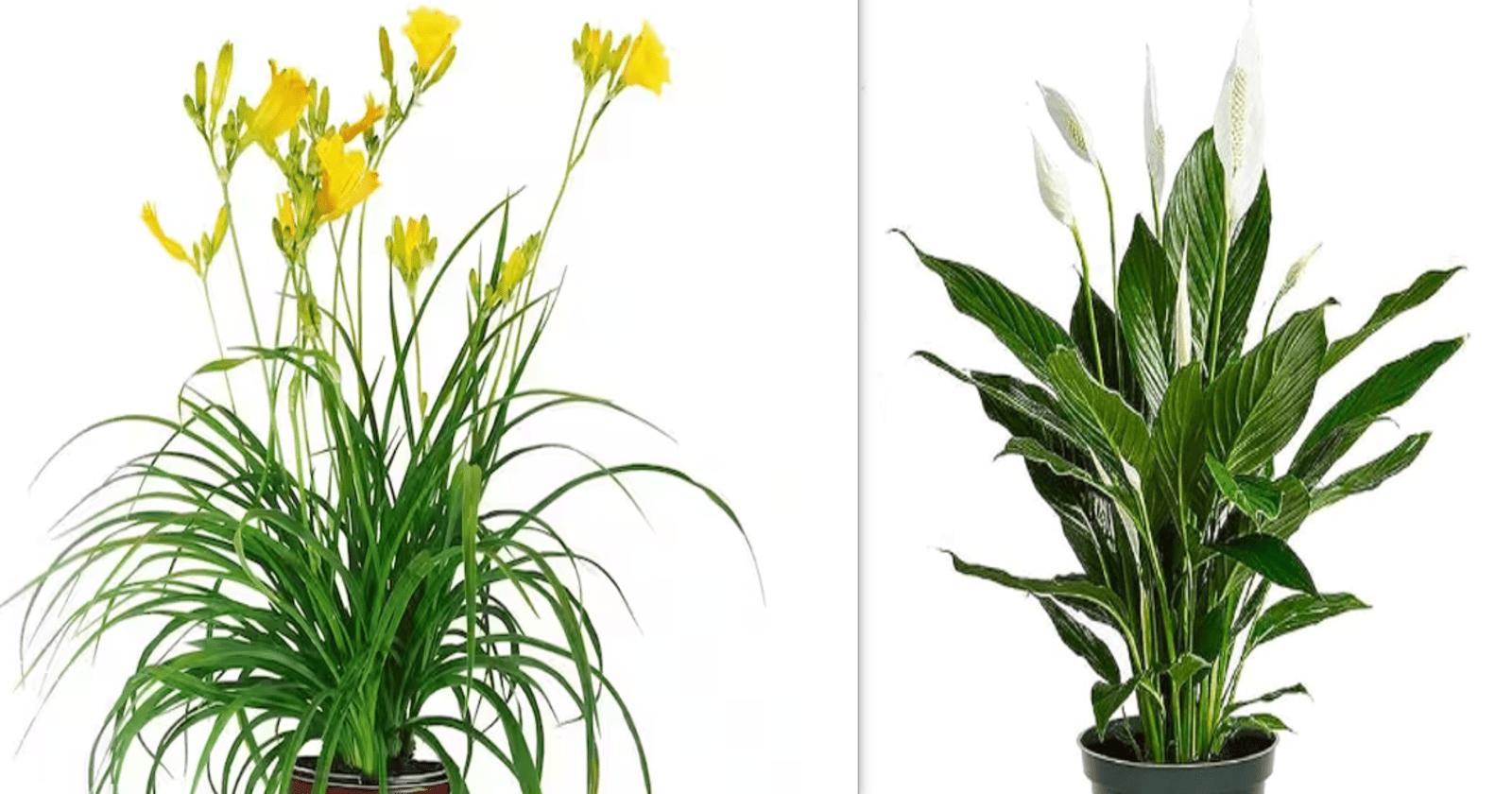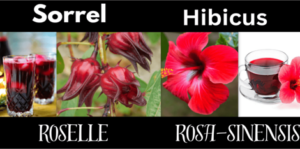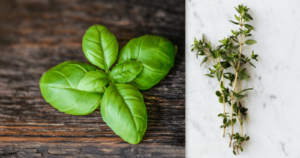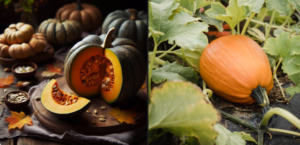Day lily an edible perennial outdoor plant, flowering bloom last only a day vs Peace lily an indoor plant, with air purifying abilities, white flower bloom that last several days.
Daylilies (Hemerocallis) a Chinese Vegetable are perennial plants known for their vibrant and diverse blooms, typically lasting for a single day. Peace lilies (Spathiphyllum), on the other hand, are indoor houseplants with elegant, white spathe flowers and dark green leaves, renowned for their air-purifying qualities. While daylilies thrive outdoors in gardens, peace lilies are popular for their adaptability to indoor environments and their ability to thrive in low light conditions.
Daylilies derive their name from the characteristic that their flowers bloom and last for only a single day. These plants, scientifically known as Hemerocallis, produce large and vibrant blooms that captivate with their ephemeral beauty. The buds of daylilies, whether in full bloom or still in the bud stage, are consumed in Chinese cuisine, both when they are freshly harvested and after being dried. In Chinese culinary traditions, daylilies are esteemed as vegetables, adding a unique flavor and texture to various dishes.
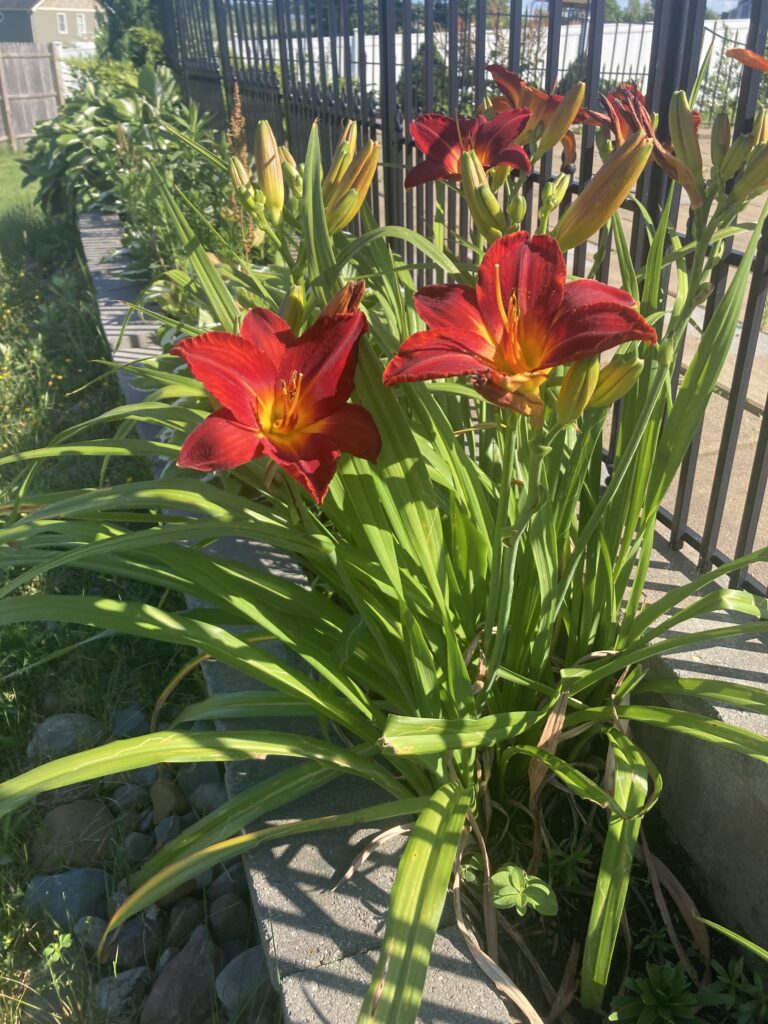
In contrast, Peace lilies (Spathiphyllum) stand as distinct indoor houseplants, prized not only for their aesthetic appeal but also for their air-purifying qualities. Characterized by elegant, white spathe flowers and lush dark green leaves, Peace lilies make for a graceful addition to indoor spaces. Beyond their ornamental value, these plants contribute to a healthier indoor environment by effectively filtering and purifying the air.
Simple Differences between Day Lilies vs Peace Lilies
| Day lily (Hemerocallis) | Peace Lily (Spathiphyllum) |
|---|---|
| Plant Type Perennial outdoor plant | Plant Type Indoor houseplant |
| Flower Characteristics Colorful, diverse, short-lived | Flower Characteristics White spathe, long-lasting |
| Growing Environment Outdoor gardens | Growing Environment Indoor environments, low light |
| Bloom Duration Each flower lasts one day | Bloom Duration Flowers last for several weeks |
| Light Requirements Full sun to partial shade | Light Requirements Low to moderate indirect light |
| Air-Purifying Qualities Not known for air purification | Air-Purifying Qualities Excellent air-purifying qualities |
| Edible A Chinese Vegetable are Consumed Chinese cuisine fresh or dry. | Edible NOT Edible ,Cause immediate mouth and throat irritation if chewed or swallowed |
What are Day Lilies?
Daylilies (Hemerocallis) are perennial flowering plants known for their vibrant and showy flowers. These plants are a part of the Asphodelaceae family and are native to Asia, particularly China and Japan. The name “daylily” is derived from the fact that each individual flower typically lasts only one day, although each stem produces multiple flowers over an extended blooming period.

Native to Asia, although in many parts of the eastern United States, the countryside is illuminated with these beautiful flowers during the summer. Daylilies have acclimated so successfully that they form large masses wherever they are allowed to grow. They tolerate any type of soil and thrive throughout the United States. Once planted, a bed of daylilies increases in size every year.
10 Fun facts about daylilies.
- Bloom Time: Daylilies are known for their short-lived flowers, with each bloom lasting only one day. However, each plant produces numerous buds, ensuring a continuous display of flowers throughout the blooming season.
- Variety: There are thousands of registered cultivars of daylilies, offering a wide range of colors, sizes, and shapes. They come in various hues, including shades of red, orange, yellow, pink, and lavender.
- Edible Flowers: Some daylily varieties have edible flowers. The petals can be used in salads, stir-fries, or as a garnish. However, it’s crucial to ensure you have identified an edible variety, as not all daylilies are suitable for consumption.
- Tough and Hardy: Daylilies are hardy and can adapt to a variety of soil conditions. They are known for their resilience and ability to thrive in both sun and partial shade. This makes them relatively easy to grow for gardeners of all experience levels.

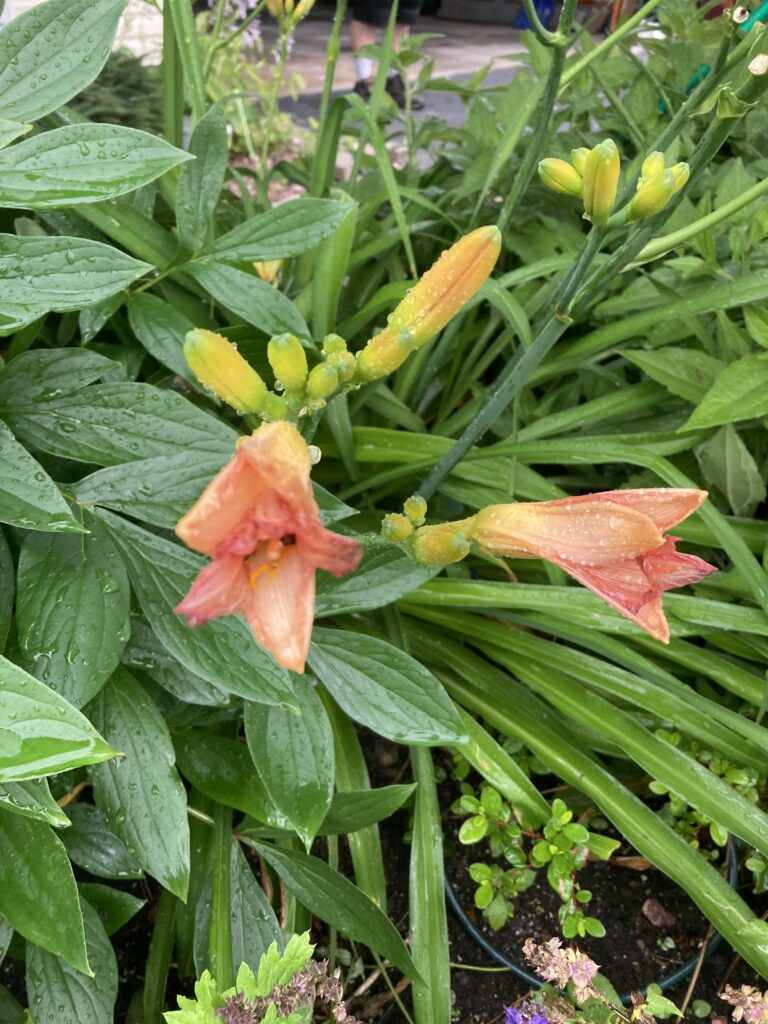
5. Historical Significance: Daylilies have a long history and are believed to have been cultivated in China for over 2,000 years. They made their way to Europe in the 16th century and later to North America.
6. Hemerocallis Etymology: The name “Hemerocallis” comes from two Greek words: “hemera,” meaning day, and “kallos,” meaning beauty. This reflects the fact that each flower lasts only one day, but the overall display is still stunning.
7. National Flower: Daylilies are the national flower of South Korea. They hold cultural significance and are often featured in traditional art and literature.
8. Drought Tolerance: Daylilies are relatively drought-tolerant once established. While they appreciate regular watering, they can withstand periods of dryness better than some other garden plants.
9. Attract Pollinators: Daylilies are attractive to pollinators such as bees and butterflies. Their vibrant colors and sweet nectar make them a favorite among these beneficial insects.
10.Hybridization: The breeding and hybridization of daylilies have led to the development of new and unique varieties with improved characteristics, such as extended bloom periods, different flower forms, and increased disease resistance.
5 Key characteristics of Day lilies include
1. Flowers: Daylily flowers come in a wide range of colors, including shades of yellow, orange, red, purple, and white. The flowers are trumpet-shaped and can have various patterns and markings.

2. Foliage: Daylilies have long, arching leaves that are green and strap-like in appearance. The foliage is often semi-evergreen, meaning it can retain some leaves throughout the winter in milder climates.
3. Adaptability: Daylilies are known for their adaptability and can thrive in various soil types and light conditions. They are hardy plants that can tolerate a range of climates.
4. Propagation: Daylilies are prolific in their ability to reproduce. Once established, they form clumps of plants, and each clump sends up multiple flower stems. They can be propagated through division, where the clumps are separated into individual plants and replanted.
5. Versatility: Daylilies are commonly used in landscaping and gardens for their beauty and easy maintenance. They work well in borders, flower beds, and even as ground cover. Some varieties are also suitable for container gardening.
Distinct Appearances of Day Lilies
The daylily grow from fleshy tuberous roots and clusters of slender strap-like leaves. The vibrant cherry-colored flowers, resembling funnels, are supported by sturdy stalks that elevate them gracefully above the leafy clusters. The common daylily, also known as the tawny daylily or tiger lily, displays burnt orange blossoms on stems that can reach up to 3 feet in height. Despite the towering flowers, the foliage clusters themselves typically measure around 2 feet in height.
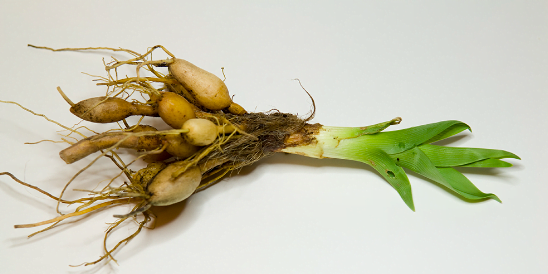
15 Some Popular types of Day lilies.
1. Stella de Oro: Known for its prolific blooming and golden-yellow flowers, most popular and widely grown Lily. Great choice for home garden and land scaping.
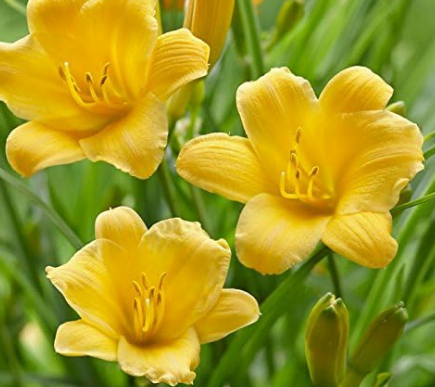
2. Hemerocallis fulva (Tawny Daylily): The wild, orange daylily often seen along roadsides cultivated as an ornamental in temperate regions due to its striking flowers and straightforward cultivation. Although it bears the common name “lily,” it is not a true member of the Lilium genus. The nomenclature arises from the flowers’ superficial resemblance to true lilies and the characteristic of each bloom lasting only a single day.

3. Hyperion: Features lemon-yellow flowers and a strong fragrance.
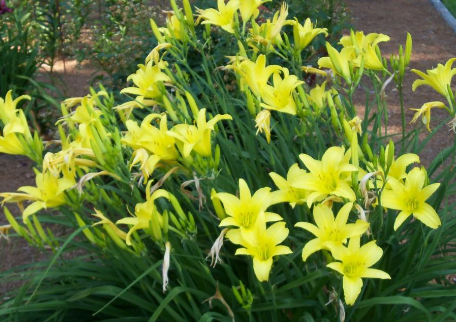
4. Happy Returns: Reblooming variety with lemon-yellow blossoms.
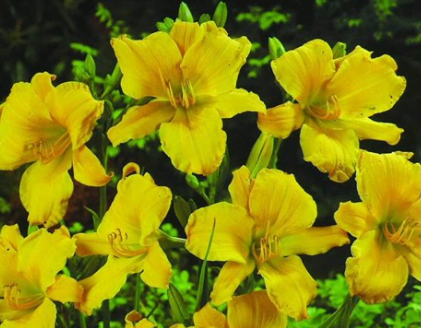
5. Purple de Oro: Exhibits purple-toned flowers with a golden throat.

6. Pardon Me: A compact daylily with deep red blooms and a reblooming habit.

7. Kwanso: Double-flowered daylily with multiple layers of orange petals.

8. Frans Hals: Displays bicolored flowers with orange and red tones.
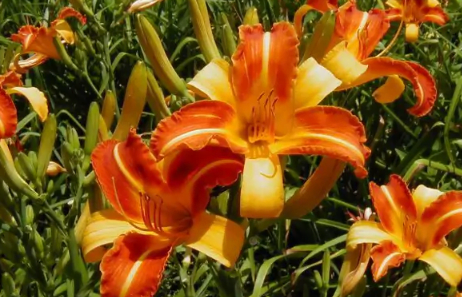
9. Elegant Candy: Pink and cream-colored flowers with a ruffled edge.

10. Chicago Apache: Deep red, spider-type daylily with striking petals.
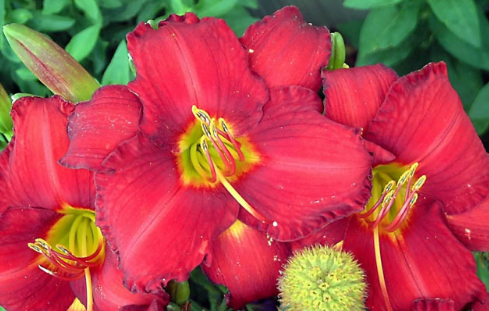
11. Gentle Shepherd: White daylily with a greenish throat and ruffled edges.
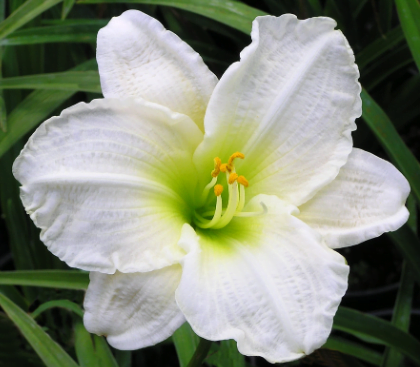
12. Little Grapette: Compact daylily with small, grape-colored flowers.
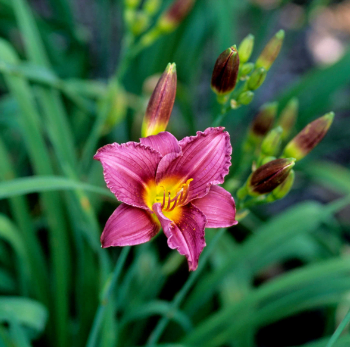
13. Pandora’s Box: Unique flowers with a combination of lavender and cream.

14. Catherine Woodbury: Light lavender daylily with a contrasting yellow throat.
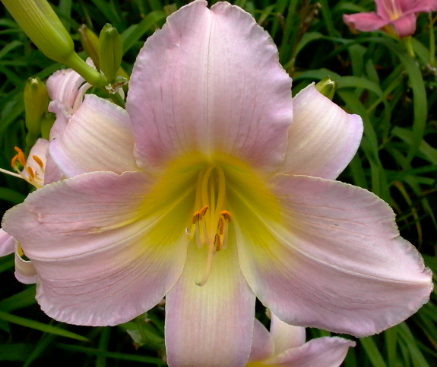
15. Custard Candy: Pastel-colored daylily with a blend of yellow and pink.
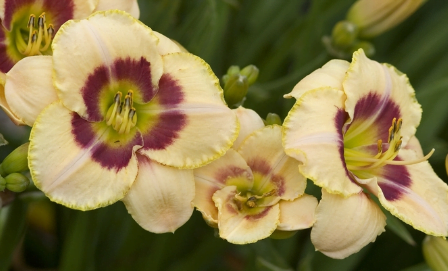
Tips on how to Identify the parts and types of Day Lilies that are Edible.
It’s crucial to note that not all daylilies are safe to eat. Some varieties can be toxic. Ensure that you are using Hemerocallis species specifically known to be edible. Orange Daylilies (Hemerocallis fulva): The common orange daylily found in many gardens is generally considered edible. However, caution is advised, as there have been reports of allergic reactions in some individuals.
Edible Parts:
- Flowers: Daylily flowers are the most commonly used part in cooking. They have a mild, slightly sweet flavor and add color to dishes.
- Buds: The unopened flower buds can be used similarly to the flowers.
- Young Shoots: Some varieties of daylilies have tender young shoots that can be harvested and cooked.
- Flowers:
- Only consume the petals. The flower petals are the most commonly eaten part of daylilies.
- Ensure that you’re dealing with true daylilies (Hemerocallis species) and not other lily varieties, as some lilies can be toxic.
- Variety:
- Stick to well-known edible varieties like Hemerocallis fulva (orange daylily) and Hemerocallis lilioasphodelus (yellow daylily). These varieties are more commonly recognized as safe for consumption.
- Avoid Wild Varieties:
- Be cautious about consuming daylilies growing in the wild, as they may not be of a known edible variety and could potentially be toxic.
- Buds:
- Unopened flower buds can be edible as well. They are often used in culinary preparations.
- Stamen and Pistil:
- Remove the reproductive parts (stamen and pistil) from the center of the flower, as they can be bitter.
- Taste Test:
- Before consuming a large quantity, taste a small amount to ensure that the particular variety you have is palatable.
- Plant Part Identification:
- Familiarize yourself with the different parts of the plant. Inedible parts include the roots, stems, and leaves.
- Culinary Uses:
- Daylilies are often used in salads, stir-fries, or as a garnish. Incorporate them into dishes in moderation.
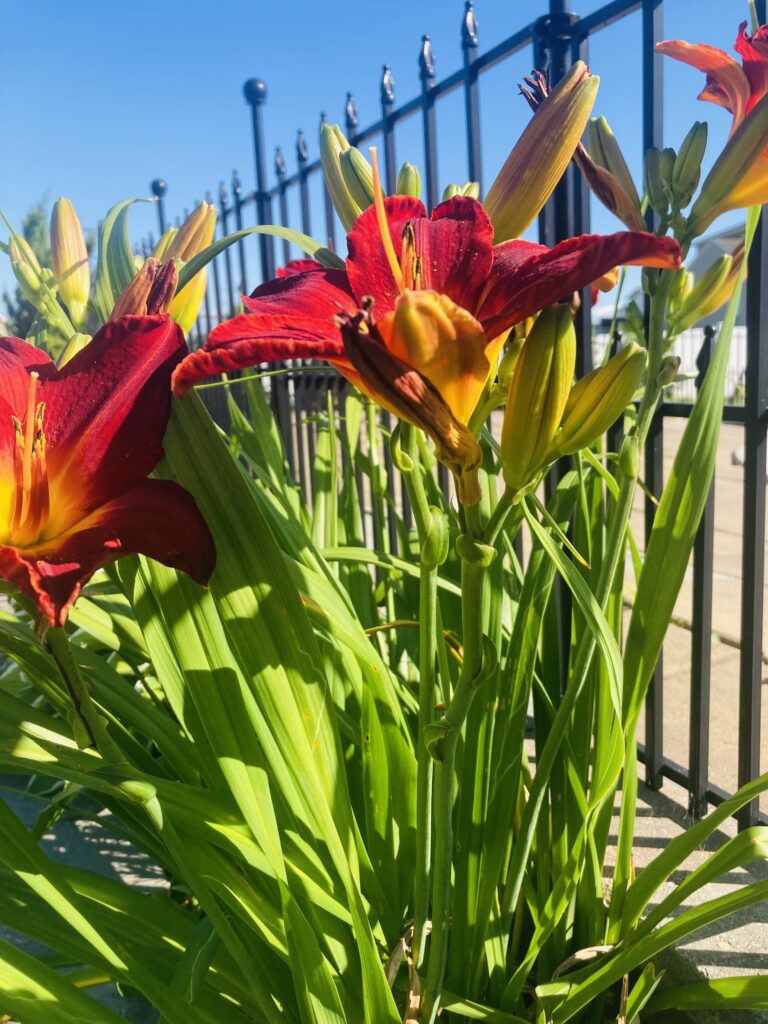
9. Research:
- Consult reputable sources, books, or experienced foragers to get more information about edible daylilies in your region.
10. Local Knowledge:
- If you’re foraging for daylilies, local knowledge is essential. Learn from experienced foragers or consult with local botanical experts.
Culinary Uses Of Day Lily
- Salads: Daylily flowers can be used in salads to add color and a mild, sweet flavor.
- Stir-Fries: Add daylily buds or flowers to stir-fries for a unique touch.
- Soups: Use daylilies in soups or as a garnish.
- Tempura: Coat the flowers or buds in tempura batter and fry them for a crispy treat.
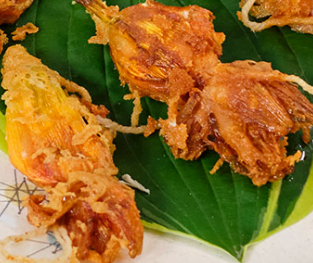
- Teas: Some cultures use daylily petals to make tea.
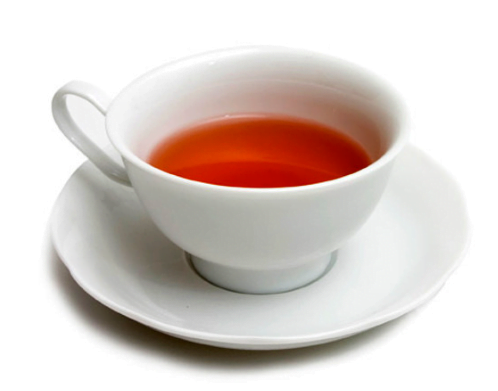
- Day Lily Fritters: These are very delicious and are a very nice summer treat.

Basic Steps to grow Day lily (Table form)
| Step | Description |
|---|---|
| 1. Selection of Daylily Variety | Choose a daylily variety that suits your climate and preferences. Daylilies come in various colors, sizes, and bloom times. Consider factors such as sunlight requirements and soil conditions. |
| 2. Planting Time | Plant daylilies in spring or fall. Spring planting allows them to establish before the heat of summer, while fall planting allows roots to develop before winter. |
| 3. Sunlight | Provide full to partial sunlight. Daylilies generally thrive in at least six hours of direct sunlight per day, though some varieties can tolerate partial shade. |
| 4. Soil Preparation | Plant daylilies in well-draining soil with a pH between 6.0 and 6.5. Incorporate organic matter like compost to improve soil structure and fertility. |
| 5. Planting Depth | Set the daylily crown (where the roots meet the foliage) at soil level. Space multiple plants according to the specific requirements of the chosen daylily variety. |
| 6. Watering | Keep the soil consistently moist, especially during the initial establishment period. Once established, daylilies are somewhat drought-tolerant but benefit from regular watering. |
| 7. Mulching | Apply a layer of organic mulch around the plants to retain moisture, suppress weeds, and regulate soil temperature. Mulching also enhances the soil’s organic content over time. |
| 8. Fertilization | Feed daylilies with a balanced, slow-release fertilizer in spring as new growth emerges. Follow package instructions for application rates. Avoid excessive nitrogen, which can reduce blooming. |
| 9. Deadheading | Remove spent blooms to encourage continuous flowering. Deadheading prevents the plant from using energy to produce seeds and redirects it to new growth and flower production. |
| 10. Division | Divide daylilies every 3-5 years to maintain vigor and prevent overcrowding. Divide clumps in early spring or late summer, replanting the divided sections in prepared soil. |
| 11. Pest and Disease Control | Monitor for pests such as aphids or spider mites. Treat with insecticidal soap or neem oil as needed. Keep an eye out for diseases like rust; remove and destroy affected foliage promptly. |
| 12. Winter Care | In colder climates, apply a layer of mulch to protect daylilies during winter. Mulch helps insulate the soil and prevents temperature fluctuations that can damage the plants’ roots. |
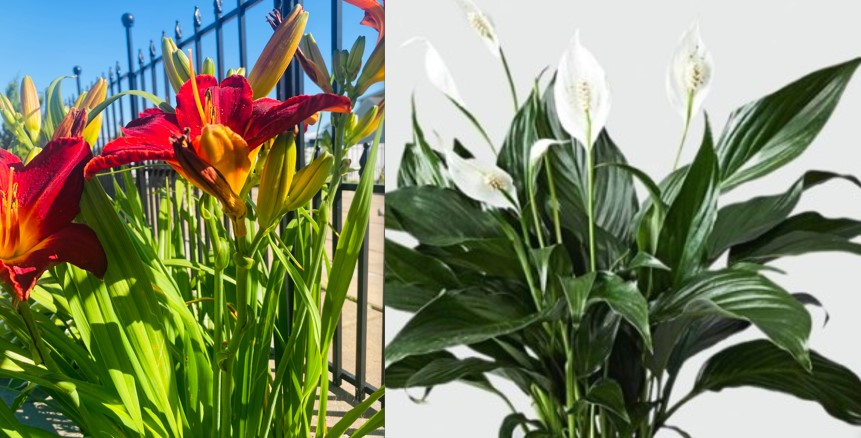
10 important tips on how to Harvest Day Lily correctly.

- Choose the Right Time:
- Harvest daylily flowers in the morning when they are fully open and at their peak freshness.
- Select blooms that are free from dew or rain to prevent excess moisture.
- Inspect the Flowers:
- Ensure that the daylily flowers you plan to harvest are healthy, free from pests, and have vibrant colors.
- Cut the Flowers Properly:
- Cut the daylily flower stem close to the base of the plant, leaving some stem attached. This prevents damage to the plant and encourages additional blooms.
- Avoid Harvesting Seed Pods:
- If you’re harvesting daylilies for culinary purposes, focus on the petals and discard the reproductive parts (stamens, pistils, and seed pods) as they can have a bitter taste.
- Handle with Care:
- Handle the harvested daylilies gently to avoid bruising or damaging the delicate petals.
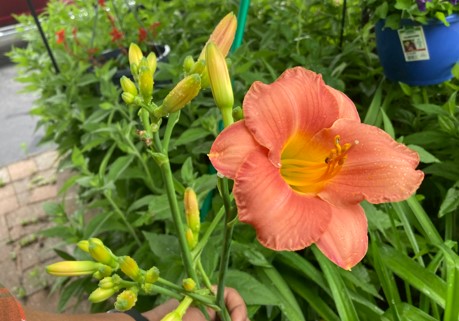

- Transport and Store Carefully:
- If you’re not using the daylilies immediately, place them in a clean container with a damp paper towel to maintain moisture. Store them in the refrigerator for short-term use.
- Remove Unwanted Parts:
- Before using daylilies in recipes, remove any green parts, the bitter reproductive organs, and the base of the flower. Use only the tender, colorful petals.


- Rinse if Necessary:
- If there is any dirt or debris on the daylilies, gently rinse them with cool water before use. Pat them dry with a clean cloth or paper towel.
- Use Promptly:
- Daylilies are best when used fresh. Incorporate them into salads, stir-fries, or other dishes promptly for the most vibrant flavor.
Basic Health Benefits and Nutritional value of Day Lily.
| Nutrient/Property | Value/Description |
|---|---|
| Antioxidants | Rich in carotenoids, flavonoids, anthocyanin, and rutin. |
| Rutin Content | Up to 19% in the methanol extract of daylily flowers. |
| Antioxidant Activity | Rutin, a key component, exhibits potent antioxidant properties. |
| Behavioral Effects | Rutin shows potential antidepressant effects in behavioral models. |
| Sleep Improvement | Daylily flowers have been associated with improved sleeping patterns. |
| Memory Enhancement | Studies indicate that daylily flowers may enhance memory. |
| Extract Comparison | Alcohol extracts of daylily flowers exhibit better biological activities than aqueous extract |
The values and effects mentioned are based on studies and research findings, and individual responses may vary.
Rutin is highlighted as a potential active component with antioxidant and antidepressant properties.
Nutritional Value
| Nutrient Content (per 100g) | Daylily Buds |
|---|---|
| Protein | High |
| Vitamin C | High |
| Vitamin A | High |
| Zeaxanthin | High |
| Lutein | High |
What is a Peace Lilies
The peace lily, scientifically known as Spathiphyllum, is a popular indoor plant that is valued for its attractive foliage and distinctive white blooms. It is native to tropical regions of the Americas and Southeast Asia. The peace lily is a member of the Araceae family and is known for its easy care and air-purifying qualities.

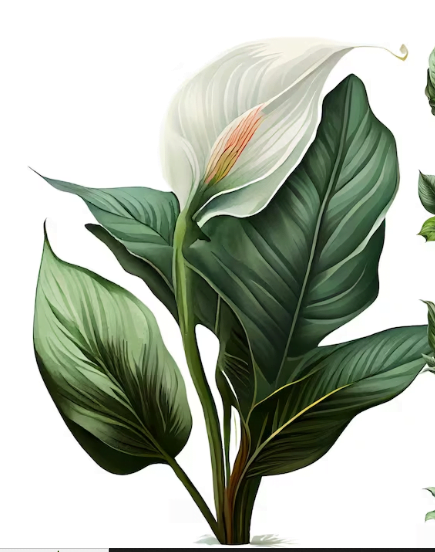
Step-by-step guide to help you care for daylilies
- Planting:
- Choose a well-draining location with at least 6 hours of sunlight per day.
- Plant daylilies in the spring or fall, as these are the best times for establishing new plants.
- Ensure the soil is enriched with organic matter and has a slightly acidic to slightly alkaline pH (around 6.0-7.0).
- Watering:
- Daylilies are drought-tolerant once established, but they benefit from regular watering, especially during dry spells.
- Water deeply, allowing the soil to dry between waterings. Avoid waterlogged conditions.
- Mulching:
- Apply a layer of organic mulch (such as straw or bark) around the base of the plants. This helps retain moisture, suppress weeds, and regulate soil temperature.


4. Fertilizing:
- Fertilize daylilies in the spring as they emerge and again after they finish flowering. A balanced, slow-release fertilizer works well.
- Follow the package instructions for the specific fertilizer you choose.
5. Deadheading:
- Remove spent flowers regularly to encourage continuous blooming.
- Trim the flower stalks to the base after the last bloom of the season to maintain a tidy appearance.
6. Division:
- Daylilies benefit from division every 3-5 years to prevent overcrowding and promote better flowering.
- Divide the clumps in the spring or fall, making sure each division has healthy roots and foliage.
7. Pest and Disease Control:
- Daylilies are relatively resistant to pests and diseases, but it’s essential to monitor for common issues such as aphids, spider mites, and slugs.
- Treat any pest problems promptly, and practice good garden hygiene to prevent diseases.
8. Staking:
- Tall or top-heavy varieties may benefit from staking to prevent them from bending or breaking in strong winds or heavy rains.
9. Winter Care:
- Daylilies are hardy plants, but in colder climates, you can apply a layer of mulch in the fall to protect the roots from extreme temperatures.
- Cut back the foliage after it dies back in the fall or early winter.
10. Observation:
- Regularly inspect your daylilies for signs of stress, disease, or pests. Early detection allows for timely intervention.
Characteristics of the peace lily include:
- Foliage: The plant has glossy, dark green leaves that are lance-shaped and arch gracefully. The leaves can grow up to a foot long, creating a lush and attractive display.
- Flowers: The most distinctive feature of the peace lily is its white, hood-like flowers. The flowers consist of a white spathe (modified leaf) surrounding a spadix (spike), which contains tiny, true flowers.
- Air-purifying qualities: Peace lilies are known for their ability to purify indoor air by removing certain pollutants such as formaldehyde, benzene, and ammonia.
- Light requirements: While peace lilies can tolerate low light conditions, they prefer bright, indirect light. They should not be exposed to direct sunlight, as it can scorch their leaves.
- Watering: Peace lilies prefer consistently moist soil but can tolerate brief periods of dryness. Overwatering can lead to root rot, so it’s essential to allow the soil to dry out slightly between watering’s.
- Temperature and humidity: They thrive in warm indoor temperatures and prefer higher humidity levels. However, they can adapt to average home conditions.
- Size: Depending on the variety, peace lilies can range in size from small tabletop plants to larger floor plants.
Toxicity of Peace Lily You should consider if you have Dogs, Cats and children in your home.
Peace lilies are toxic to cats, dogs, and humans if ingested. It’s essential to keep them out of reach of pets and children. The plant’s toxicity is due to the presence of compounds like oxalates, which are needle-shaped crystals that can irritate the mouth, tongue, and throat. Here are more details on the toxicity of peace lilies:
- Oral irritation: If any part of the peace lily is chewed or ingested, it can lead to irritation of the mouth and digestive tract. This may result in symptoms such as drooling, difficulty swallowing, and nausea.
- Gastrointestinal upset: In addition to oral irritation, consumption of peace lily may cause gastrointestinal upset, including vomiting and diarrhea. These symptoms can be more pronounced if a significant amount of the plant material is ingested.
- Skin irritation: Contact with the plant’s sap or juices can sometimes cause skin irritation in sensitive individuals. It’s a good idea to wash the affected area with soap and water if skin contact occurs.
- Ocular irritation: If the sap comes into contact with the eyes, it can cause irritation. In such cases, it’s important to flush the eyes with water and seek medical attention if irritation persists.
- Toxicity in pets: Cats and dogs are more likely to be affected by peace lily toxicity if they chew or ingest parts of the plant. Symptoms in pets can include drooling, pawing at the mouth, vomiting, and difficulty swallowing. In severe cases, it can lead to more serious health issues.
- Toxicity in humans: While peace lilies are generally not fatal when ingested in small amounts, they can cause discomfort and symptoms as described above in humans.
In the event of suspected peace lily ingestion or exposure, it is crucial to seek prompt medical attention, especially for pets or children. If a pet has ingested any part of the plant, contact a veterinarian immediately. If a child has ingested the plant, contact a poison control center or seek emergency medical care.
Common types of peace lilies
1.Spathiphyllum wallisii: This is the most common and widely available peace lily. It has dark green, lance-shaped leaves and produces the characteristic white, hood-like flowers. It is a relatively compact plant, making it suitable for tabletops and smaller spaces.

2. Spathiphyllum domino: This cultivar has variegated leaves with white markings, adding an extra element of visual interest. The variegation can vary, and the plant still produces the typical white flowers.
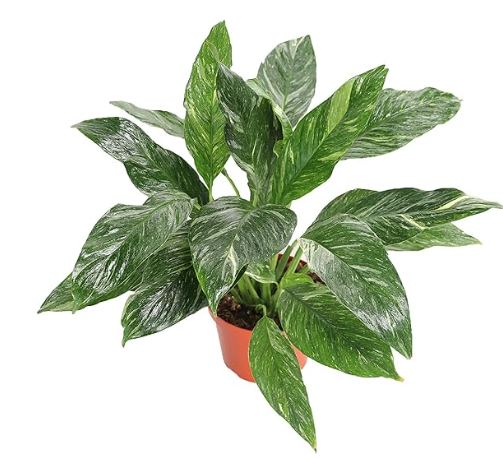
3. Spathiphyllum sensation: This variety is known for its larger size compared to the standard peace lily. It has broad, dark green leaves and can grow to be quite impressive, making it suitable for larger spaces.

4. Spathiphyllum mauna loa: This is a larger cultivar with broad leaves and can grow to be quite tall. It produces the classic white flowers and is often chosen for its substantial and elegant appearance.
5.Spathiphyllum ‘Clevelandii’: This cultivar is recognized for its dark green, glossy leaves and larger white spathes. It’s a popular choice for indoor landscapes.
6. Spathiphyllum ‘Sweet Chico’: This is a dwarf variety of peace lily, making it suitable for smaller spaces. It has a compact growth habit and still produces the characteristic white flowers.
7.Spathiphyllum ‘Power Petite’: Another compact variety, ‘Power Petite’ is known for its smaller size and shorter stature. It’s a good choice for those looking for a more petite peace lily.
8.Spathiphyllum ‘Mojo Lime’: This cultivar stands out for its lime-green flowers, providing a unique twist on the classic white blooms. The foliage is also often variegated.
11 key ideas on Step-by-step guide to help you grow a healthy peace lily
- Choosing the Right Location:
- Peace lilies prefer bright, indirect light. Avoid direct sunlight, as it can scorch their leaves.
- They can tolerate lower light conditions but may not bloom as profusely.
- Temperature and Humidity:
- Keep your peace lily in a warm environment. They thrive in temperatures between 65-80°F (18-27°C).
- Maintain a higher humidity level if possible. Placing a tray of water near the plant or using a humidifier can help.
- Watering:
- Keep the soil consistently moist but not waterlogged. Peace lilies are sensitive to both underwatering and overwatering.
- Water when the top inch of soil feels dry to the touch. Water more frequently during the growing season (spring and summer) and reduce watering in the dormant season (fall and winter).
- Soil:
- Use a well-draining potting mix. A mix designed for orchids or a general-purpose mix with added perlite or vermiculite works well.
- Repot the peace lily every 1-2 years, or when you notice it becoming root-bound.
- Fertilizing:
- Feed your peace lily with a balanced, liquid fertilizer every 4-6 weeks during the growing season. Dilute the fertilizer to half the recommended strength.
- Avoid fertilizing during the dormant season.
- Pruning:
- Remove yellow or brown leaves regularly to encourage new growth.
- Prune the plant if it becomes leggy or outgrows its space.
- Pest Control:
- Keep an eye out for pests like spider mites and scale. If you notice any, wipe the leaves with a damp cloth or use insecticidal soap.
- Repotting:
- Repot your peace lily if it becomes root-bound or outgrows its container. Choose a pot that is 1-2 inches larger in diameter than the current one.
- Flowering:
- Peace lilies produce white bracts that surround the actual flowers. They bloom best in higher light conditions.
- Propagation:
- Peace lilies can be propagated by division. When repotting, carefully separate the plant into smaller sections, each with roots attached.
- Dormancy:
- Peace lilies may go through a dormant period in the fall and winter when growth slows. During this time, reduce watering and fertilizing.
Health and Environmental Benefits of Peace Lily
- Air Purification:
- Peace lilies are known for their ability to filter indoor air pollutants. They can help remove common toxins such as formaldehyde, benzene, and trichloroethylene. This makes them a popular choice for indoor spaces, especially homes and offices.
- Humidity Control:
- Peace lilies release moisture into the air through a process called transpiration. This can help increase humidity in dry indoor environments, promoting respiratory health and reducing the likelihood of conditions like dry skin and irritated mucous membranes.
- Mood Enhancement:
- Having indoor plants, including peace lilies, has been associated with improved mood and reduced stress levels. The presence of greenery can create a more positive and calming atmosphere in living and working spaces.
- Reduced Volatile Organic Compounds (VOCs):
- Peace lilies contribute to the reduction of volatile organic compounds (VOCs) in the air. VOCs are emitted by various household products, and exposure to high levels of these compounds can have negative effects on health. By absorbing and breaking down VOCs, peace lilies can contribute to a healthier indoor environment.
- Allergen Reduction:
- While not a direct health benefit, peace lilies can help reduce airborne allergens. The plant’s ability to capture and neutralize particles can be beneficial for individuals with allergies or respiratory conditions.
- Aesthetic and Psychological Benefits:
- The presence of indoor plants, including peace lilies, can have a positive impact on mental well-being. People often find joy and satisfaction in caring for plants, and the visual appeal of greenery can enhance the overall aesthetics of a space.
How peace lily work to purify air in homes and offices
Peace lilies (Spathiphyllum spp.) are known for their ability to improve indoor air quality by removing certain pollutants. They achieve this through a process known as phytoremediation, where plants absorb and neutralize harmful chemicals. Here’s how peace lilies work to purify the air:
- Removal of Airborne Chemicals:
- Benzene: Peace lilies can absorb benzene, a common indoor air pollutant found in items like paints, furniture wax, and certain cleaning products.
- Formaldehyde: This chemical is often present in household items such as plywood, carpeting, and some cleaning products. Peace lilies help filter out formaldehyde from the air.
- Trichloroethylene: Peace lilies are effective at removing trichloroethylene, which can be found in some industrial solvents and cleaning agents.
- Transpiration and Filtration:
- Peace lilies engage in a natural process called transpiration, where they take in air through small pores on their leaves (stomata). This process allows the plant to absorb airborne pollutants.
- The absorbed pollutants are then transported to the plant’s roots, where they are either broken down or stored.
- Microbial Action in the Soil:
- Some pollutants absorbed by the plant may be broken down by microbes in the soil around the plant’s roots.
- The soil acts as a filter, helping to trap and break down certain pollutants before they can re-enter the air.
- Increase in Oxygen Levels:
- As peace lilies photosynthesize, they convert carbon dioxide into oxygen. This natural process helps increase the oxygen levels in the surrounding air.
- Enhanced Humidity:
- Peace lilies release water vapor during transpiration, which can increase the humidity in the air. This is beneficial in indoor environments, especially those with dry air.
In summary, daylilies offer a fascinating duality—outdoors, they enchant with their brief yet stunning blossoms, while in Chinese cuisine, they are recognized as a versatile and delectable vegetable. On the other hand, Peace lilies showcase their elegance indoors, gracing living spaces with their beautiful flowers and providing the added benefit of improving air quality.
Resources
Name of Book : Growing Chinese Vegetables in Your Own Backyard Publisher: Storey Publishing, LLC Publication Date: March 25, 2009 Language: English Format: Paperback Number of Pages: 216 ISBN-10: 1603421408 ISBN-13: 978-1603421409
https://www.pbs.org/food/kitchen-vignettes/daylily-fritters-edible-flowers/
